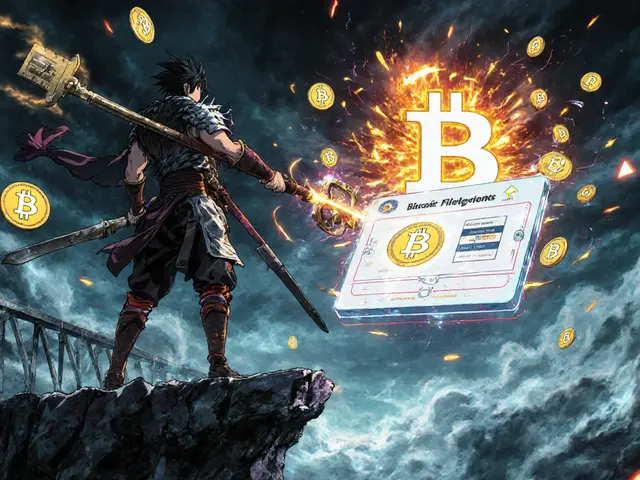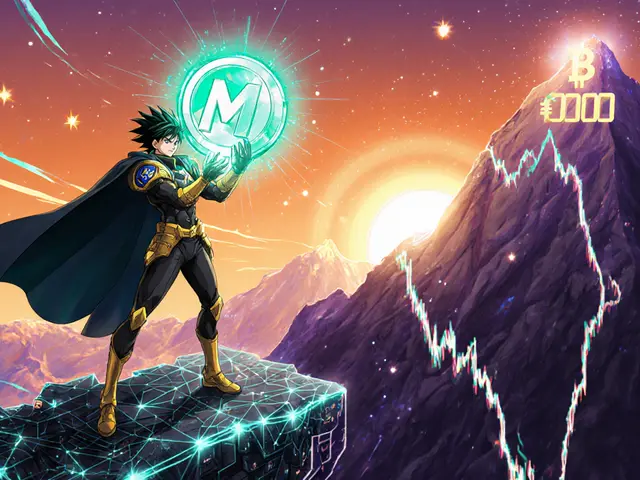Security Token vs Traditional Securities Liquidity Comparison
Security Token
Digital securities on blockchain with smart contract automation.
Traditional Security
Stocks, bonds, and derivatives traded on regulated exchanges.
Liquidity Comparison Metrics
Security Token Advantages
- Instant settlement in seconds
- 24/7 global trading
- Fractional ownership possibilities
- Reduced intermediary costs
- Immutable audit trails
Traditional Security Advantages
- Established regulatory framework
- High liquidity for major exchanges
- Proven investor protections
- Wide availability of information
- Centralized custody services
When investors talk about security token liquidity, they’re weighing how fast and cheap a digital security can change hands against the old‑school process of buying a stock or bond on a regulated exchange. The rise of blockchain‑based securities has turned the liquidity conversation on its head, promising 24/7 trading, fractional ownership, and near‑instant settlement. This article breaks down exactly how security tokens stack up against traditional securities, shows where the advantages are real, and points out the hurdles that still need clearing.
Quick Takeaways
- Security tokens settle in seconds, while traditional securities often take two business days.
- Fractional ownership lets investors buy into million‑dollar assets with a few hundred dollars.
- Trading is continuous on blockchain platforms, compared to fixed market hours for stocks and bonds.
- Cost structures shrink dramatically once intermediaries are removed, but network fees can still bite.
- Regulatory compliance is baked into smart contracts, yet jurisdictional uncertainty remains a risk.
Defining the Core Players
Security Token is a digitally native, blockchain‑recorded security that complies with securities law while leveraging smart‑contract automation. It emerged from regulated Security Token Offerings (STOs) as a bridge between crypto assets and traditional finance.
Traditional Security refers to stocks, bonds, or derivatives issued and traded on regulated exchanges, governed by centralized intermediaries such as brokers, custodians, and transfer agents.
Blockchain is a distributed ledger technology that records transactions in immutable blocks, enabling transparent and tamper‑proof asset ownership.
Smart Contract is self‑executing code stored on a blockchain that automatically enforces the terms of an agreement without human intervention.
Security Token Offering (STO) is a regulated fundraising method where issuers sell security tokens to accredited investors, meeting the same disclosure requirements as a registered securities offering.
Decentralized Exchange (DEX) is an on‑chain marketplace that matches buyers and sellers directly, using automated market makers or order books without a central custodian.
Automated Market Maker (AMM) is a liquidity‑pool‑based trading algorithm that provides price quotes based on the ratio of assets in the pool, enabling instant swaps on a DEX.
Fractional Ownership allows investors to hold a portion of an asset-be it real estate, art, or a corporate share-represented by a fraction of a token.
Regulatory Compliance in the security‑token world is enforced on‑chain through whitelist checks, transfer restrictions, and immutable audit trails embedded in smart contracts.
Liquidity Mechanics: How They Differ
Liquidity is essentially how quickly you can convert an asset into cash without moving the price too much. Security tokens gain three technical edge points:
- Instant Settlement: Smart contracts lock in buyer and seller consent, then transfer ownership in a single blockchain transaction-usually under a minute.
- Continuous Trading: Because a DEX runs 24/7, there’s no “market close” window. Buyers can place orders any time, any day, as long as they stay within jurisdictional limits.
- Fractional Granularity: Tokens can be divided to eight or more decimal places, meaning investors can buy a $100 slice of a $10million real‑estate deal.
Traditional securities, by contrast, rely on centralized clearinghouses that batch transactions, leading to:
- Two‑day T+2 settlement cycles.
- Trading limited to exchange hours (e.g., 9:30am‑4:00pm EST for NYSE).
- Minimum lot sizes often measured in whole shares, which can be prohibitively expensive for high‑priced stocks.
Side‑by‑Side Comparison
| Attribute | Security Tokens | Traditional Securities |
|---|---|---|
| Settlement Time | Seconds to minutes (on‑chain) | Typically T+2 (two business days) |
| Trading Hours | 24/7 global | Exchange‑specific hours; closed on weekends/holidays |
| Minimum Investment | Often $100-$1,000 (fractional) | Whole shares; can be $10,000+ for high‑price stocks |
| Cost Structure | Smart‑contract gas fees + platform fee (usually <1% total) | Broker commissions, clearing fees, custodian fees (often 1-3%) |
| Transparency | Public ledger; real‑time ownership data | Periodic reporting; ownership records held off‑chain |
| Liquidity Sources | DEXs, AMMs, institutional token pools | Exchange order books, market makers |
Real‑World Liquidity Numbers
Tokenized real‑estate platforms have published turnover data that illustrates the liquidity boost. In the first six months of a pilot, average monthly turnover was about 15%-meaning a given property changed owners roughly 1.8 times per year. As the market matured, that figure settled around 5% monthly, still far higher than comparable illiquid real‑estate assets that rarely exceed 1% annual turnover.
When the same assets were listed on a popular DEX (using an AMM pool), they showed an 8.62‑percentage‑point liquidity premium over unlisted tokens. Even after market adjustments, the premium stayed at about 3.76percentage points, confirming that on‑chain liquidity mechanisms add measurable value.
Traditional equity markets, by comparison, still experience average daily turnover rates of 0.2-0.3% for large‑cap stocks, but that volume is concentrated in a handful of mega‑cap securities. For most mid‑ and small‑cap stocks, daily turnover can dip below 0.05%.

Cost Implications: Fees, Gas, and Hidden Expenses
Security‑token platforms charge a platform fee (usually 0.2-0.5%) and the network’s gas fee, which fluctuates with blockchain congestion. On Ethereum’s mainnet, a typical token transfer might cost $5-$15 in gas as of October2025, but Layer‑2 solutions (e.g., Arbitrum, Optimism) have driven that down to sub‑$1 for many trades.
Traditional brokers still collect commission fees (often $0‑$4 per trade for retail accounts) plus custodial fees and, for institutional players, clearinghouse charges that can add up to 0.5-1% of trade value.
The net effect is that for low‑value trades (under $5,000), security tokens can be cheaper if gas costs are low, while high‑value trades still see traditional broker fees compete favorably when gas spikes.
Regulatory Guardrails: On‑Chain vs Off‑Chain
Both worlds must obey securities law, but security tokens embed compliance directly into the token’s code. A whitelist check can prevent an unqualified address from receiving a token, and a transfer‐restriction clause can enforce holding periods. Every transaction leaves an immutable audit trail, simplifying reporting for regulators.
Traditional securities rely on post‑trade reporting, manual record‑keeping, and third‑party compliance teams. While this has proven reliable for decades, it adds latency and cost. The on‑chain model reduces these frictions but introduces new risks: smart‑contract bugs, jurisdictional clashes, and the need for up‑to‑date legal mapping for every token.
Practical Steps to Trade Security Tokens
- Choose a compliant platform (e.g., Tokeny, Securitize, or a regulated DEX).
- Complete KYC/AML verification-usually a simple ID upload and a short questionnaire.
- Set up a non‑custodial wallet that supports the token’s blockchain (MetaMask for Ethereum, Phantom for Solana, etc.).
- Deposit fiat or crypto to fund your wallet; many platforms accept wire transfer, ACH, or stable‑coin conversion.
- Navigate to the secondary market page, review the token’s smart‑contract compliance rules, and place a buy or sell order.
- Confirm the transaction; the network will broadcast it and settle within seconds.
Most platforms guide users through each step, but newcomers should budget an extra day for identity verification and ensure they store private keys securely.
Pitfalls to Watch Out For
- Regulatory Uncertainty: Not all jurisdictions have clear rules for security tokens; investing from a region without explicit guidance can expose you to legal risk.
- Smart‑Contract Bugs: A coding error can freeze token transfers. Stick to platforms that have undergone third‑party audits.
- Network Congestion: High gas fees can erode profit margins, especially for frequent traders.
- Liquidity Gaps: Not every token has a deep AMM pool. Check the pool’s depth before committing large sums.
- Tax Complexity: Token trades generate capital‑gain events in many jurisdictions; keep detailed transaction logs.
Future Outlook: Will Security Tokens Overtake Traditional Liquidity?
Industry analysts project that tokenized assets could capture 5-10% of the global securities market by 2030, driven by three forces: regulatory clarity, institutional adoption, and improvements in layer‑2 scalability. If gas fees stay low and compliance frameworks solidify, the liquidity advantage will become even more pronounced, especially for illiquid asset classes like private equity, real estate, and fine art.
However, full mainstream adoption still hinges on solving the legal patchwork and building user‑friendly wallet experiences. Traditional securities benefit from entrenched infrastructure, deep liquidity pools, and investor familiarity. In the short term, a hybrid approach-holding both tokenized and conventional assets-makes the most sense for most investors.
Frequently Asked Questions
Can I trade security tokens on the same platforms I use for cryptocurrencies?
Only if the platform is licensed to handle securities. Some crypto‑focused DEXs have added compliance layers (e.g., Binance’s regulated token market), but pure‑play crypto exchanges without a securities license cannot legally list security tokens.
Do security tokens guarantee lower fees than stocks?
Generally yes for small‑to‑medium trades, because you avoid broker commissions and custodial fees. However, during periods of high blockchain congestion, gas fees can exceed traditional trading costs, so the advantage isn’t absolute.
Is the liquidity of a security token the same across all blockchains?
No. Liquidity depends on the ecosystem. Ethereum‑based tokens benefit from large DEX volumes but suffer higher gas fees, while tokens on newer chains (e.g., Polygon, Solana) may have cheaper transactions but smaller order books.
What regulatory reports do I need to file when I sell a security token?
Treat the sale as a capital‑gain event. You’ll need to report the proceeds, cost basis, and holding period on your tax return, just as you would for a stock. Many platforms provide CSV statements to simplify this process.
Will security tokens replace traditional stocks entirely?
Not in the near term. Traditional markets have deep liquidity, regulatory certainty, and investor trust that take years to build. Security tokens will likely coexist, carving out niches where fractional ownership and 24/7 trading provide clear added value.









Comments (13)
Sophie Sturdevant
October 29, 2024 AT 08:34 AMInstant settlement is a game‑changer for liquidity.
Nathan Blades
November 10, 2024 AT 02:34 AMWhen you look at the throughput of on‑chain swaps, the velocity is off the charts; you’re basically turning the order‑book into a real‑time data stream. The drama of 24/7 trading fuels a relentless feedback loop where price discovery never sleeps. Smart‑contract checkpoints act like automated auditors, keeping the ledger pristine while slashing counterparty risk. Think of it as a turbo‑charged engine for capital that traditionally idled at the exchange close. In short, the ecosystem is morphing from a batch‑process to a continuous‑flow model.
Somesh Nikam
November 21, 2024 AT 20:34 PMThat continuous‑flow vibe really lowers the barrier for newcomers, especially when you can start with a few hundred bucks. I’ve seen friends from non‑finance backgrounds dip their toes in because fractional tokens make the entry point humane. The on‑chain audit trail also eases the anxiety around hidden fees, which is a big win for everyday investors. It’s cool to see the network effect amplify as more participants join the pool.
Jan B.
December 3, 2024 AT 14:34 PMRegulatory scaffolding still leans heavily on legacy frameworks, so the compliance layer can feel like stitching a patch onto an old blanket.
MARLIN RIVERA
December 15, 2024 AT 08:34 AMThis whole token hype is just a glorified Ponzi circus; you trade seconds, but you lose control to opaque code.
Debby Haime
December 27, 2024 AT 02:34 AMWhile the code can be opaque, the community audits and formal verification tools are closing that gap faster than the market can get reckless.
emmanuel omari
January 7, 2025 AT 20:34 PMOnly the United States has the legal muscle to enforce cross‑border token settlements; other jurisdictions are just playing catch‑up.
Andy Cox
January 19, 2025 AT 14:34 PMFrom a cultural standpoint, the shift to 24/7 markets mirrors how we binge‑watch shows-no pauses, just constant flow.
Courtney Winq-Microblading
January 31, 2025 AT 08:34 AMThat constant flow raises philosophical questions about value perception; if price never sleeps, does the notion of scarcity lose its grip?
katie littlewood
February 12, 2025 AT 02:34 AMLiquidity in the token sphere is not merely a metric, it is a narrative that reshapes investor psychology.
When a token can be sliced into micro‑units, the psychological barrier of "I can’t afford that stock" evaporates.
Investors start to think in terms of portfolios of fractions rather than whole‑share monoliths.
This granular approach democratizes exposure to high‑value assets that were previously out of reach.
Moreover, the reduction in settlement latency curtails the infamous "overnight risk" that haunts traditional traders.
By settling in seconds, counterparties can re‑allocate capital almost instantly, creating a virtuous liquidity loop.
Smart contracts also embed compliance rules, so the regulatory friction is programmed, not retrofitted.
That automation lightens the operational overhead for custodians and brokers alike.
Cost structures shift dramatically: gas fees replace broker commissions, but the net effect is often a lower total expense ratio.
Nevertheless, network congestion can spike gas prices, occasionally inflating transaction costs beyond traditional spreads.
Hence, the economic calculus must factor in both on‑chain fees and market impact.
From a macro perspective, the global 24/7 market dilutes the advantage of localized exchange timing.
Arbitrage opportunities proliferate, but they also demand sophisticated bots to capture fleeting differentials.
Investors who embrace these tools can extract alpha that was previously reserved for high‑frequency firms.
In essence, the liquidity architecture of security tokens is a double‑edged sword: it unlocks unprecedented access while demanding new technical competencies.
Adapting to this reality will separate forward‑thinking participants from those clinging to legacy paradigms.
Jenae Lawler
February 23, 2025 AT 20:34 PMOne must not overlook the epistemic hazard of assuming that speed alone equates to superiority; the legal corpus has evolved over centuries to safeguard market integrity, a nuance that cannot be obviated by mere code.
Chad Fraser
March 7, 2025 AT 14:34 PMBottom line: mix the tech glow with traditional due‑diligence, and you’ll craft a portfolio that’s both nimble and robust.
Jayne McCann
March 19, 2025 AT 08:34 AMHonestly, I think the whole token frenzy is just a passing fad that will fizzle out.